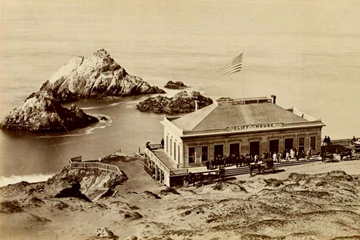
Carleton Eugene Watkins
American , 1829-1916
Cliff House and Seal Rocks, 1868
vintage albumin print from a glass negative
SBMA, Museum purchase with funds provided by the Docent Council in memory of Cliff Hauenstein
RESEARCH PAPER
Carleton Watkins was born on November 11, 1829, the first of eight children in the rural village of Oneonta, New York. Oneonta was a "sleepy hamlet" until the new turnpike transformed the town into a transportation hub and Daily coaches from New York and New Jersey brought travelers, current news and prosperity to the village. Watkins' father, John Watkins, was a carpenter and then innkeeper operating the Oneonta House, beginning in 1842.
Growing up in Oneonta, N.Y., Watkins and his friends explored the natural environment with ease. There was fishing and swimming in the river which ran under the town bridge and hiking in the woods just across the newly built turnpike. An idyllic childhood where the community and nature seemed naturally connected. This seamless harmony contributed to his lifelong appreciation of the natural world and is evident in his photographs of the country's majestic wilderness and western expansion.
In August, 1849, the New York Herald was the first paper on the east coast to publish that gold had been discovered in CA. Oneonta friends including Collis Huntington (later to become one of the "big four" owners of the Central Pacific Railroad) and George W. Murray left Oneonta to seek their fortune in California. Watkins followed in 1850 and at the age of 20, he is living in Sacramento, working for Huntington, delivering supplies to the mines during the gold rush. When this enterprise closes, he begins employment as a stationer and bookseller in Murray's bookstore. By 1853, Murray relocates to San Francisco taking Watkins with him to manage the new bookstore. Two years later, when Murray returns to Sacramento, Watkins accepts an offer to fill in for an absentee photographer at the studio of Robert Vance, whose gallery is situated one block away. It is here that he learned the photographic techniques and processes that he would perfect during his career.
By 1858, (age 29) Watkins was working on his own as a freelance photographer, taking on a number of photographic commissions producing photographs for evidence in trials, and seen as the "go-to" photographer of choice for owners of wealthy estates in San Francisco such as John C. Fremont, who commissioned him to document his Mariposa Estate. He also formed an association with the California State Geological Survey in Yosemite to photograph this natural wonder that leads to the preservation of Yosemite as a public trust.
The photograph in the SBMA collection is an albumen print, the most prevalent type of print made throughout the 19 th century. Watkins' photograph of Cliff House on Seal Rocks is a classical, well ordered picture with strong architectural lines, a frame and clapboard building on the edge of the ocean where clarity and order prevail. It embraces a classical ideal in its search for balance, harmony and integration of both subject and imagery.
The photograph is taken from above, looking down unto the Cliff House, the quality of light on the water, creates a harmonious relationship of the manmade with the surrounding natural beauty of the Pacific Ocean and Seal Rocks. Perched on the northwest edge of the San Francisco peninsula, in America's principle western city, Cliff House presents a visual symbol of America's growth "from sea to shining sea". Today, the Cliff House is, once again, an important San Francisco landmark and enjoys a reputation for fine dining with magnificent views of the Pacific Ocean. This classical, restrained approach characterizes Watkins' artistic style.
Cliff House was taken at a time when Watkins was one of the best known landscape photographers in the world. Following his first photographic expedition in Yosemite in the summer of 1861, his reputation was securely established, and for the next two decades he created some of the finest American Landscape photographs of the nineteenth century. His artistic vision created a heroic view of the American Landscape and culture that endures today.
Carleton Watkins is widely acknowledged to be among the great 19 th century American photographers. He had a simple motto: "to stand where the view looks best." He was an artist in the strictest sense of the word and possibly the first American to show a purely photographic imagination.
Prepared for the SBMA Docent Council, October 20, 2009 by Ann Robinson
Bibliography
Carleton E. Watkins, Photographer of the American West. Peter E. Palmquist.
Albuquerque: University of New Mexico Press, 1983.
Carleton Watkins, The Art of Perception . Douglas R. Nickel. New York: Harry N.
Abrams, Inc., 1999.
http://www.sfmuseum.org/loc/clfhouse.html
